
Star Wars is an American epic space opera media franchise created by George Lucas, which began with the eponymous 1977 film and quickly became a worldwide pop culture phenomenon. The franchise has been expanded into various films and other media, including television series, video games, novels, comic books, theme park attractions, and themed areas, comprising an all-encompassing fictional universe. Star Wars is one of the highest-grossing media franchises of all time.

Return of the Jedi is a 1983 American epic space opera film directed by Richard Marquand. The screenplay is by Lawrence Kasdan and George Lucas from a story by Lucas, who was also the executive producer. The sequel to Star Wars (1977) and The Empire Strikes Back (1980), it is the third installment in the original Star Wars trilogy, the third film to be produced, and the sixth chronological film in the "Skywalker Saga". The film stars Mark Hamill, Harrison Ford, Carrie Fisher, Billy Dee Williams, Anthony Daniels, David Prowse, Kenny Baker, Peter Mayhew and Frank Oz.
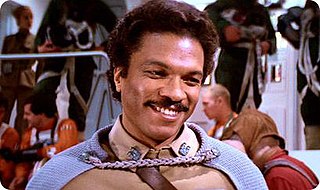
Landonis Balthazar "Lando" Calrissian III is a fictional character in the Star Wars franchise. He was introduced in The Empire Strikes Back (1980) as an old friend of Han Solo and the administrator of the floating Cloud City on the gas planet Bespin. Prior to the events of the film, Lando made a career as a gambler, con artist, playboy, mining engineer, and businessman, and was the owner of the Millennium Falcon until losing the ship to Han in a bet. In the film, when Cloud City is threatened by the Galactic Empire, Lando reluctantly betrays Han to Darth Vader, but later redeems himself by helping Han's friends escape from the Empire. In Return of the Jedi (1983), after becoming a general in the Rebel Alliance, Lando helps rescue Han from Jabba the Hutt and leads the attack on the second Death Star.
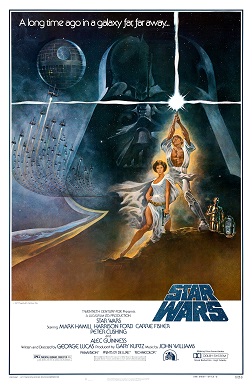
Star Wars is a 1977 American epic space opera film written and directed by George Lucas, produced by Lucasfilm and distributed by 20th Century-Fox. It was the first film released in the Star Wars film series and the fourth chronological chapter of the "Skywalker Saga". Set "a long time ago" in a fictional universe where the galaxy is ruled by the tyrannical Galactic Empire, the story focuses on a group of freedom fighters known as the Rebel Alliance, who aim to destroy the Empire's newest weapon, the Death Star. When Rebel leader Princess Leia is apprehended by the Empire, Luke Skywalker acquires stolen architectural plans of the Death Star and sets out to rescue her while learning the ways of a metaphysical power known as "the Force" from Jedi Master Obi-Wan Kenobi. The cast includes Mark Hamill, Harrison Ford, Carrie Fisher, Peter Cushing, Alec Guinness, David Prowse, James Earl Jones, Anthony Daniels, Kenny Baker, and Peter Mayhew.

The Empire Strikes Back is a 1980 American epic space opera film directed by Irvin Kershner from a screenplay by Leigh Brackett and Lawrence Kasdan, based on a story by George Lucas. The sequel to Star Wars (1977), it is the second film in the Star Wars film series and the fifth chronological chapter of the "Skywalker Saga". Set three years after the events of Star Wars, the film recounts the battle between the malevolent Galactic Empire, led by the Emperor, and the Rebel Alliance, led by Princess Leia. Luke Skywalker trains to master the Force so he can confront the powerful Sith lord, Darth Vader. The ensemble cast includes Mark Hamill, Harrison Ford, Carrie Fisher, Billy Dee Williams, Anthony Daniels, David Prowse, Kenny Baker, Peter Mayhew, and Frank Oz.
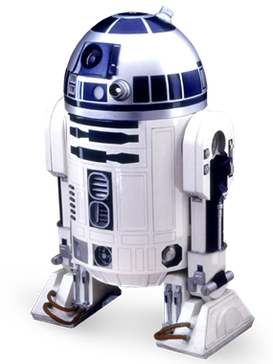
R2-D2 or Artoo-Detoo is a fictional robot character in the Star Wars franchise created by George Lucas. He has appeared in ten of the eleven theatrical Star Wars films to date, including every movie in the original trilogy, prequel trilogy, and sequel trilogy. At various points throughout the course of the films, R2, an astromech droid, is a friend to C-3PO, Padmé Amidala, Anakin Skywalker, Leia Organa, Luke Skywalker, and Obi-Wan Kenobi. R2-D2 and his companion C-3PO are the only characters to appear in every theatrical Star Wars film, with the exception of Solo: A Star Wars Story (2018).

C-3PO or See-Threepio is a humanoid robot character in the Star Wars franchise who appears in every movie of the original trilogy, the prequel trilogy and the sequel trilogy. Built by Anakin Skywalker, C-3PO was designed as a protocol droid intended to assist in etiquette, customs, and translation, boasting that he is "fluent in over six million forms of communication". Along with his astromech droid counterpart and friend R2-D2, C-3PO provides comic relief within the narrative structure of the films, and serves as a foil. Anthony Daniels has portrayed the character in eleven of the twelve theatrical Star Wars films released to date, with the exception of Solo: A Star Wars Story, where the character does not appear.

Greedo Tetsu Jr. is a fictional character in the Star Wars franchise. He was a Rodian bounty hunter from the Tetsu Clan and worked for gangster Jabba the Hutt. Greedo's Huttese language is based on Quechua, the Inca language. He appears in the first Star Wars film during a scene where he confronts and threatens Han Solo, only to be killed by Solo. The scene was later altered so that Greedo also shoots at Han, leading to the infamous fan controversy known as "Han shot first" with which the character has since come to be best-known.

The Star Wars science fiction media franchise is acknowledged to have been inspired by many sources. These include Hinduism, Buddhism, Qigong, philosophy, classical mythology, Roman history, Gnosticism, Zoroastrianism, parts of the other Abrahamic religions, Confucianism, Shintō and Taoism, and countless cinematic precursors. Creator George Lucas stated "Most of the spiritual reality in the movie[s] is based on a synthesis of all religions. A synthesis through history; the way man has perceived the unknown and the great mystery and tried to deal with that or dealing with it".

Changes in Star Wars re-releases vary from minor differences in color timing, audio mixing, and take choices to major insertions of new visual effects, additions of characters and dialogue, scene expansions, and replacement of original cast members with newer ones. Though changes were also made to the prequel trilogy, the original trilogy saw the most alteration. Dissatisfied with the original theatrical cuts of the original Star Wars film, The Empire Strikes Back, and Return of the Jedi, creator George Lucas altered the films in ways that were ostensibly not initially possible, primarily due to limitations of time, budget, and technology.
The original Star Wars trilogy, formerly marketed as the Star Wars Trilogy, is the first set of three films produced in the Star Wars franchise, an American space opera created by George Lucas. It was produced by Lucasfilm and distributed by 20th Century Fox, and consists of Star Wars (1977), The Empire Strikes Back (1980) and Return of the Jedi (1983). Beginning in medias res, the original trilogy serves as the second act of the nine-episode Skywalker saga. It was followed by a prequel trilogy between 1999 and 2005, and a sequel trilogy between 2015 and 2019. Collectively, they are referred to as the "Skywalker Saga" to distinguish them from spin-off films set within the same universe.
The Star Wars sequel trilogy is the third trilogy of the main Star Wars franchise, an American space opera created by George Lucas. It is produced by Lucasfilm Ltd. and distributed by Walt Disney Studios Motion Pictures. The trilogy consists of episodes VII through IX, chronologically following the prequel trilogy and the original trilogy, serving as the final act of the "Skywalker saga". Lucas had planned a sequel trilogy as early as 1976, but canceled it by 1981. He produced only the first six episodes, and for a time described these as comprising the complete story. The sequel trilogy concept was revived when the Walt Disney Company entered negotiations to acquire Lucasfilm in 2011. Lucas produced new story treatments, but these were largely discarded. Both the acquisition and plans to produce the trilogy were announced in late 2012.

Jabba Desilijic Tiure, more commonly known as Jabba the Hutt, is a fictional character and major antagonist in the Star Wars franchise. Created by George Lucas, Jabba is voiced by Larry Ward with several puppeteers inside a one-ton puppet portraying him in Return of the Jedi. He was originally supposed to first appear in Star Wars (1977) as a stop motion character with Declan Mulholland as his stand-in. Jabba was later added into the film as a CGI character when it was re-released in Special Edition in 1997. He also appears in the prequel movie The Phantom Menace. The character is a large slug-like creature based on annelid worms and originally designed as an apelike figure.

Han Solo is a fictional character in the Star Wars franchise created by George Lucas. The character first appeared in the 1977 film Star Wars portrayed by Harrison Ford, who reprised his role in The Holiday Special (1978), The Empire Strikes Back (1980), and Return of the Jedi (1983). Ford returned to the role for The Force Awakens (2015), as well as a brief cameo in The Rise of Skywalker (2019). In the spin-off film Solo (2018), a younger version of the character is portrayed by Alden Ehrenreich, while in the animated series Forces of Destiny (2017–2018), the character is voiced by Kiff VandenHeuvel and A. J. Locascio.

The Millennium Falcon is a fictional starship in the Star Wars franchise. Designed by Joe Johnston for the movie Star Wars (1977), it has subsequently appeared in The Star Wars Holiday Special (1978), The Empire Strikes Back (1980), Return of the Jedi (1983), The Force Awakens (2015), The Last Jedi (2017), Solo: A Star Wars Story (2018), and The Rise of Skywalker (2019). Additionally, the Falcon appears in a variety of Star Wars spin-off works, including books, comics, and games; James Luceno's novel Millennium Falcon focuses on the titular ship. It also appears in the 2014 animated film The Lego Movie in Lego form.
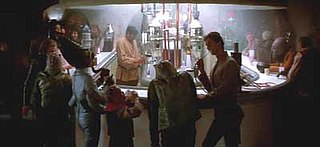
Mos Eisley is a spaceport town in the fictional Star Wars universe. Located on the planet Tatooine, it first appeared in the 1977 film Star Wars, described by the character Obi-Wan Kenobi as a "wretched hive of scum and villainy".
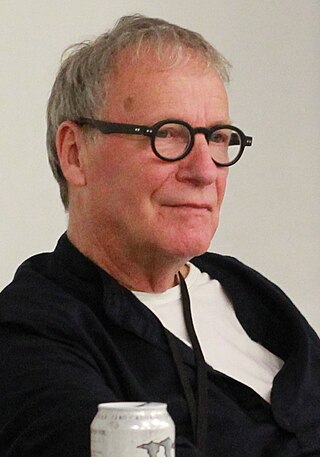
Paul Blake is an English actor. He is best known for portraying Greedo in Star Wars. He also had minor roles in Some of My Best Friends Are... and Hennessy, as well as some roles in television series such as Down to Earth and Crossroads. He played many roles in theatres both in the UK and abroad; including the title role in Macbeth at Salisbury Playhouse and Charles Swann in the Glasgow Citizen's Theatre production A Waste of Time amongst many others.
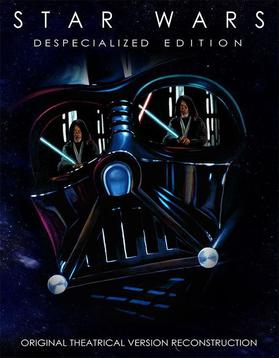
Star Wars: The Despecialized Edition, also known as Harmy's Despecialized Edition, is a fan-created film preservation of the original Star Wars trilogy films: Star Wars (1977), The Empire Strikes Back (1980) and Return of the Jedi (1983). It is a high-quality replica of the out-of-print theatrical versions, created by a team of Star Wars fans with the intention of preserving the films, culturally and historically. The project was led by Petr Harmáček, then an English teacher, from Plzeň, Czech Republic under the online alias Harmy.

Solo: A Star Wars Story is a 2018 American space Western film centering on the Star Wars character Han Solo. Directed by Ron Howard, produced by Lucasfilm, and distributed by Walt Disney Studios Motion Pictures, it is the second Star Wars anthology film, following Rogue One (2016). Alden Ehrenreich stars as Solo, with Woody Harrelson, Emilia Clarke, Donald Glover, Thandiwe Newton, Phoebe Waller-Bridge, Joonas Suotamo, and Paul Bettany. The film tells the origin story of Han Solo and Chewbacca, who join a heist within the criminal underworld ten years prior to the events of A New Hope.

















